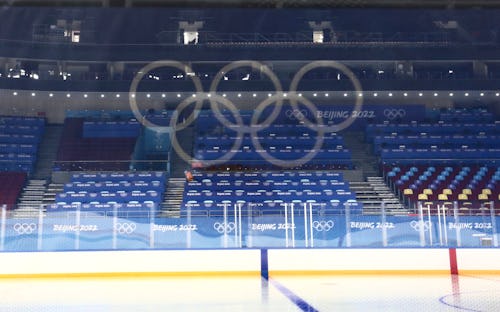Climate change might kill the Winter Olympics
The controversial cold-weather Games in Beijing could also be one of the last.

Welcome to the 2022 Winter Olympics, the 24th and possibly last time that the world will gather to compete on ice and snow. According to a study published in the journal Current Issues in Tourism, the number of suitable host cities for the event, which happens every four years, is dwindling because of climate change. As the planet warms, the number of locations that will be able to reliably count on cold weather and snowfall will shrink, and the Games will become increasingly dangerous for athletes to compete in.
Prior to this year’s Olympics in Beijing, there have been 20 cities that have played host to the international cold-weather competition. Of those 20, just one is projected to have the conditions necessary to host the Games by the end of the century if we continue on our current trajectory of greenhouse gas emissions, according to the study. The lucky winner: Sapporo, Japan, which hosted the 1972 Winter Olympics. Lake Placid in New York and the cities of Lillehammer and Oslo in Norway are projected to be safe until midcentury, at which point conditions will erode to the point that they won’t be able to produce safe conditions throughout the winter months.
It wouldn’t be the worst thing in the world to only host the Olympics in one place; preparation for the games tends to be costly and a major burden on the environment. But ideally, we’d choose to keep the Olympics in one place out of a sense of responsibility, not out of necessity.
It’s a delicate balance, and climate change is anything but delicate.
The Winter Olympics are a particularly tricky event to host because they are so dependent on the weather. It’s not just about clear skies and ideal temperatures; you need very specific conditions to maintain the courses. It needs to be cold — below freezing, actually — but not so cold that the snow becomes icy and heavy. When the temperatures get too cold during skating or luge events, the ice gets sticky and it changes how the blades interact with the surface. It’s a delicate balance, and climate change is anything but delicate.
Because of this, the Winter Olympics have increasingly relied on human-made conditions. Fake snow has dominated the last few Winter Games: About 80% of the powdery white material at the 2014 event in Sochi, Russia, was manufactured, and as much as 90% of the snow at the Winter Olympics in Pyeongchang, South Korea, was fake. At this year’s Olympics, they’re going all the way. Beijing will use all artificial snow because the real stuff is just too hard to come by — at least in the necessary quantities and conditions to supply the whole Games. And while it’s easier to manufacture, manage, and maintain, the fake stuff is not great for the athletes. Skiers report the material burns their skin when they come into contact with it.
While faking winter conditions is nothing new, China is taking it to a new extreme. The country is reportedly planning on trying to alter the weather around the Games by using a technique called cloud-seeding, which adds chemicals to the air in order to artificially increase the odds of precipitation. The result often creates clear skies and can be used to avoid potential unwanted weather like hailstorms — but no one is really sure what the effects of weather altering at such a large scale may be. China doesn’t seem deterred by the potential risks, though, and the illusion of clear skies is appealing for a city notoriously marred by pollution.
The country is taking fake it ‘til you make it to its logical conclusion, and faking everything as it relates to the Winter Olympics. It seems like that may be the only way we’ll get the Winter Games in the future.